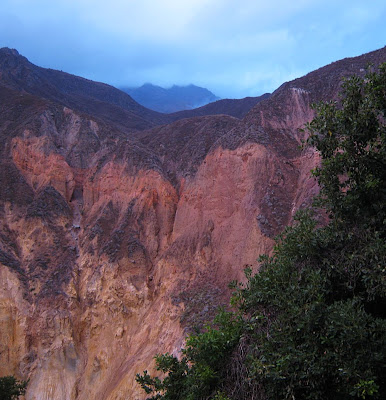Speaking of which, after the first 5 minutes, my pack felt like it weighed 60 pounds instead of 30. My legs were sore and my thighs ached with every step. But I kept going slow and steady, never running out of breath, and I soon felt better. Or at least, my legs got numb to the pain. I took breaks only when nature called, and took off my pack only once, to change some layerage. Before I knew it we were in the final stretch:
I was setting a personal altitude record with every step, and soon enough we were at the top. It was cold and windy, so we headed down immediately, took a break for lunch, and then descended the rest of the 1000 meters down to Yanama.
Once there we procured another cheap floor and began the search for donkeys. We were pretty beat up, and from what we'd heard a day's use of donkeys would be about half as expensive as buying a day's food from a village. Unfortunately, at this point we were pretty much down to dollars, and it's pretty tough to pay with dollars when the nearest money-changer is 2 days away. But the kids at the house we were staying (maybe 15 years old?) agreed to take us to Meizcal, a 4-hour walk. 20 dollars seemed pretty steep, so we negotiated to include some snacks in the deal as well.
It was looking like we might make it. It would be really, really tough, but certainly possible. We'll never know, though, whether we could've made it, because fate intervened that night. David woke up with a fever, and that morning said that he felt weaker than he'd ever felt in his entire life. From Meizcal it would be 2 tough days in either direction to get to civilization, and we didn't know where this illness was going to lead. So we convinced the boys to take our packs to the top of the pass instead, and returned to Totora.
Despite not carrying packs, the way back seemed much harder than the first time. We arrived in Totora midday, got in our sleeping bags and promptly slept for about 15 hours, only taking a short break to cook up some ramen for dinner. The next day we took the road instead of the trail, encountered a bus after a couple of hours, and by nightfall were in Aguas Calientes.
The next day we took the train to Ollataytambo (yes, the train that we had taken pains to avoid the first time), and then took a colectivo to Cusco, on which a girl both drew a picture and wrote a recipe (for peanut milk) in my notebook.
Were we disappointed that we ended the trek? For sure. But I think to continue would've been unsafe. And I got some of the best experiences (and pictures) of the entire trip, so I think it was still worthwhile.
Heading back to Yanama to grab my forgotten sandals, I snapped this photo, one of my favorites of the trip.
The trail back up to the pass.
Obstacles on the way.
.





































